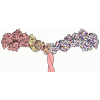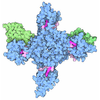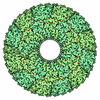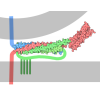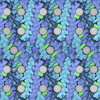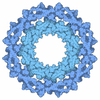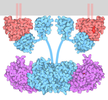[English] 日本語
 Yorodumi
Yorodumi- PDB-9qvn: Cryo-EM reconstruction of the NEDD1 anchor protein bound to the g... -
+ Open data
Open data
- Basic information
Basic information
| Entry | Database: PDB / ID: 9qvn | |||||||||
|---|---|---|---|---|---|---|---|---|---|---|
| Title | Cryo-EM reconstruction of the NEDD1 anchor protein bound to the gamma-tubulin ring complex | |||||||||
 Components Components |
| |||||||||
 Keywords Keywords | STRUCTURAL PROTEIN / Tubulin complex | |||||||||
| Function / homology |  Function and homology information Function and homology informationmicrotubule nucleation by interphase microtubule organizing center / gamma-tubulin complex localization / microtubule nucleator activity / positive regulation of norepinephrine uptake / cellular response to cytochalasin B / polar microtubule / interphase microtubule organizing center / bBAF complex / gamma-tubulin complex / npBAF complex ...microtubule nucleation by interphase microtubule organizing center / gamma-tubulin complex localization / microtubule nucleator activity / positive regulation of norepinephrine uptake / cellular response to cytochalasin B / polar microtubule / interphase microtubule organizing center / bBAF complex / gamma-tubulin complex / npBAF complex / regulation of transepithelial transport / gamma-tubulin ring complex / nBAF complex / mitotic spindle microtubule / brahma complex / meiotic spindle organization / morphogenesis of a polarized epithelium / protein localization to adherens junction / structural constituent of postsynaptic actin cytoskeleton / GBAF complex / Formation of annular gap junctions / Formation of the dystrophin-glycoprotein complex (DGC) / postsynaptic actin cytoskeleton / Gap junction degradation / regulation of G0 to G1 transition / Tat protein binding / Folding of actin by CCT/TriC / dense body / Cell-extracellular matrix interactions / microtubule nucleation / Prefoldin mediated transfer of substrate to CCT/TriC / RSC-type complex / apical protein localization / regulation of double-strand break repair / regulation of nucleotide-excision repair / gamma-tubulin binding / adherens junction assembly / RHOF GTPase cycle / Adherens junctions interactions / non-motile cilium / tight junction / Sensory processing of sound by outer hair cells of the cochlea / Interaction between L1 and Ankyrins / SWI/SNF complex / regulation of mitotic metaphase/anaphase transition / Sensory processing of sound by inner hair cells of the cochlea / positive regulation of T cell differentiation / regulation of norepinephrine uptake / apical junction complex / transporter regulator activity / maintenance of blood-brain barrier / positive regulation of double-strand break repair / nitric-oxide synthase binding / establishment or maintenance of cell polarity / cortical cytoskeleton / NuA4 histone acetyltransferase complex / cell leading edge / positive regulation of stem cell population maintenance / Regulation of MITF-M-dependent genes involved in pigmentation / pericentriolar material / Recycling pathway of L1 / microtubule organizing center / regulation of G1/S transition of mitotic cell cycle / mitotic sister chromatid segregation / brush border / kinesin binding / EPH-ephrin mediated repulsion of cells / negative regulation of cell differentiation / regulation of synaptic vesicle endocytosis / mitotic spindle assembly / RHO GTPases Activate WASPs and WAVEs / positive regulation of myoblast differentiation / RHO GTPases activate IQGAPs / single fertilization / positive regulation of double-strand break repair via homologous recombination / regulation of protein localization to plasma membrane / spindle assembly / cytoplasmic microtubule / cytoplasmic microtubule organization / cytoskeleton organization / EPHB-mediated forward signaling / centriole / substantia nigra development / Loss of Nlp from mitotic centrosomes / Loss of proteins required for interphase microtubule organization from the centrosome / Recruitment of mitotic centrosome proteins and complexes / Recruitment of NuMA to mitotic centrosomes / axonogenesis / Anchoring of the basal body to the plasma membrane / calyx of Held / condensed nuclear chromosome / AURKA Activation by TPX2 / mitotic spindle organization / meiotic cell cycle / Translocation of SLC2A4 (GLUT4) to the plasma membrane / Regulation of endogenous retroelements by Piwi-interacting RNAs (piRNAs) / actin filament / adherens junction / positive regulation of cell differentiation / FCGR3A-mediated phagocytosis Similarity search - Function | |||||||||
| Biological species |  Homo sapiens (human) Homo sapiens (human) | |||||||||
| Method | ELECTRON MICROSCOPY / single particle reconstruction / cryo EM / Resolution: 4.7 Å | |||||||||
 Authors Authors | Munoz-Hernandez, H. / Xu, Y. / Wieczorek, M. | |||||||||
| Funding support |  Switzerland, 2items Switzerland, 2items
| |||||||||
 Citation Citation |  Journal: J Cell Biol / Year: 2025 Journal: J Cell Biol / Year: 2025Title: Structure of the microtubule-anchoring factor NEDD1 bound to the γ-tubulin ring complex. Authors: Hugo Muñoz-Hernández / Yixin Xu / Aitor Pellicer Camardiel / Daniel Zhang / Allen Xue / Amol Aher / Ellie Walker / Florina Marxer / Tarun M Kapoor / Michal Wieczorek /   Abstract: The γ-tubulin ring complex (γ-TuRC) is an essential multiprotein assembly that provides a template for microtubule nucleation. The γ-TuRC is recruited to microtubule-organizing centers (MTOCs) by ...The γ-tubulin ring complex (γ-TuRC) is an essential multiprotein assembly that provides a template for microtubule nucleation. The γ-TuRC is recruited to microtubule-organizing centers (MTOCs) by the evolutionarily conserved attachment factor NEDD1. However, the structural basis of the NEDD1-γ-TuRC interaction is not known. Here, we report cryo-EM structures of NEDD1 bound to the human γ-TuRC in the absence or presence of the activating factor CDK5RAP2. We found that the C-terminus of NEDD1 forms a tetrameric α-helical assembly that contacts the lumen of the γ-TuRC cone and orients its microtubule-binding domain away from the complex. The structure of the γ-TuRC simultaneously bound to NEDD1 and CDK5RAP2 reveals that both factors can associate with the "open" conformation of the complex. Our results show that NEDD1 does not induce substantial conformational changes in the γ-TuRC but suggest that anchoring of γ-TuRC-capped microtubules by NEDD1 would be structurally compatible with the significant conformational changes experienced by the γ-TuRC during microtubule nucleation. #1: Journal: bioRxiv / Year: 2024 Title: Structure of the microtubule anchoring factor NEDD1 bound to the γ-tubulin ring complex. Authors: Hugo Muñoz-Hernández / Yixin Xu / Daniel Zhang / Allen Xue / Amol Aher / Aitor Pellicer Camardiel / Ellie Walker / Florina Marxer / Tarun M Kapoor / Michal Wieczorek /   Abstract: The γ-tubulin ring complex (γ-TuRC) is an essential multiprotein assembly, in which γ-tubulin, GCP2-6, actin, MZT1 and MZT2 form an asymmetric cone-shaped structure that provides a template for ...The γ-tubulin ring complex (γ-TuRC) is an essential multiprotein assembly, in which γ-tubulin, GCP2-6, actin, MZT1 and MZT2 form an asymmetric cone-shaped structure that provides a template for microtubule nucleation. The γ-TuRC is recruited to microtubule organizing centers (MTOCs), such as centrosomes and pre-existing mitotic spindle microtubules, via the evolutionarily-conserved attachment factor NEDD1. NEDD1 contains an N-terminal WD40 domain that binds to microtubules, and a C-terminal domain that associates with the γ-TuRC. However, the structural basis of the NEDD1-γ-TuRC interaction is not known. Here, we report cryo-electron microscopy (cryo-EM) structures of NEDD1 bound to the human γ-TuRC in the absence or presence of the activating factor CDK5RAP2, which interacts with GCP2 to induce conformational changes in the γ-TuRC and promote its microtubule nucleating function. We found that the C-terminus of NEDD1 forms a tetrameric α-helical assembly that contacts the lumen of the γ-TuRC cone, is anchored to GCP4, 5 and 6 via protein modules consisting of MZT1 & GCP3 subcomplexes, and orients its microtubule-binding WD40 domains away from the complex. We biochemically tested our structural models by identifying NEDD1 mutants unable to pull-down -tubulin from cultured cells. The structure of the γ-TuRC simultaneously bound to NEDD1 and CDK5RAP2 reveals that both factors can associate with the "open" conformation of the complex. Our results show that NEDD1 does not induce conformational changes in the γ-TuRC, but suggest that anchoring of γ-TuRC-capped microtubules by NEDD1 would be structurally compatible with the significant conformational changes experienced by the γ-TuRC during microtubule nucleation. | |||||||||
| History |
|
- Structure visualization
Structure visualization
| Structure viewer | Molecule:  Molmil Molmil Jmol/JSmol Jmol/JSmol |
|---|
- Downloads & links
Downloads & links
- Download
Download
| PDBx/mmCIF format |  9qvn.cif.gz 9qvn.cif.gz | 2.5 MB | Display |  PDBx/mmCIF format PDBx/mmCIF format |
|---|---|---|---|---|
| PDB format |  pdb9qvn.ent.gz pdb9qvn.ent.gz | Display |  PDB format PDB format | |
| PDBx/mmJSON format |  9qvn.json.gz 9qvn.json.gz | Tree view |  PDBx/mmJSON format PDBx/mmJSON format | |
| Others |  Other downloads Other downloads |
-Validation report
| Summary document |  9qvn_validation.pdf.gz 9qvn_validation.pdf.gz | 1.7 MB | Display |  wwPDB validaton report wwPDB validaton report |
|---|---|---|---|---|
| Full document |  9qvn_full_validation.pdf.gz 9qvn_full_validation.pdf.gz | 1.8 MB | Display | |
| Data in XML |  9qvn_validation.xml.gz 9qvn_validation.xml.gz | 322.9 KB | Display | |
| Data in CIF |  9qvn_validation.cif.gz 9qvn_validation.cif.gz | 562.7 KB | Display | |
| Arichive directory |  https://data.pdbj.org/pub/pdb/validation_reports/qv/9qvn https://data.pdbj.org/pub/pdb/validation_reports/qv/9qvn ftp://data.pdbj.org/pub/pdb/validation_reports/qv/9qvn ftp://data.pdbj.org/pub/pdb/validation_reports/qv/9qvn | HTTPS FTP |
-Related structure data
| Related structure data |  53400MC  9qvmC M: map data used to model this data C: citing same article ( |
|---|---|
| Similar structure data | Similarity search - Function & homology  F&H Search F&H Search |
- Links
Links
- Assembly
Assembly
| Deposited unit | 
|
|---|---|
| 1 |
|
- Components
Components
-Gamma-tubulin complex component ... , 3 types, 13 molecules DFHrstuvBNKIJ
| #1: Protein | Mass: 103710.102 Da / Num. of mol.: 10 Source method: isolated from a genetically manipulated source Source: (gene. exp.)  Homo sapiens (human) / Gene: TUBGCP3, GCP3 / Production host: Homo sapiens (human) / Gene: TUBGCP3, GCP3 / Production host:  Trichoplusia ni (cabbage looper) / References: UniProt: Q96CW5 Trichoplusia ni (cabbage looper) / References: UniProt: Q96CW5#6: Protein | Mass: 76179.969 Da / Num. of mol.: 2 Source method: isolated from a genetically manipulated source Source: (gene. exp.)  Homo sapiens (human) / Gene: TUBGCP4, 76P, GCP4 / Production host: Homo sapiens (human) / Gene: TUBGCP4, 76P, GCP4 / Production host:  Trichoplusia ni (cabbage looper) / References: UniProt: Q9UGJ1 Trichoplusia ni (cabbage looper) / References: UniProt: Q9UGJ1#9: Protein | | Mass: 118467.547 Da / Num. of mol.: 1 Source method: isolated from a genetically manipulated source Source: (gene. exp.)  Homo sapiens (human) / Gene: TUBGCP5, GCP5, KIAA1899 / Production host: Homo sapiens (human) / Gene: TUBGCP5, GCP5, KIAA1899 / Production host:  Trichoplusia ni (cabbage looper) / References: UniProt: Q96RT8 Trichoplusia ni (cabbage looper) / References: UniProt: Q96RT8 |
|---|
-Protein , 6 types, 32 molecules PRSTUOQWXVYZabcefghijklmndGMCAEL
| #2: Protein | Mass: 8485.724 Da / Num. of mol.: 7 Source method: isolated from a genetically manipulated source Source: (gene. exp.)  Homo sapiens (human) / Gene: MZT1, C13orf37, MOZART1 / Production host: Homo sapiens (human) / Gene: MZT1, C13orf37, MOZART1 / Production host:  Trichoplusia ni (cabbage looper) / References: UniProt: Q08AG7 Trichoplusia ni (cabbage looper) / References: UniProt: Q08AG7#3: Protein | Mass: 72050.984 Da / Num. of mol.: 4 Source method: isolated from a genetically manipulated source Source: (gene. exp.)  Homo sapiens (human) / Gene: NEDD1 / Production host: Homo sapiens (human) / Gene: NEDD1 / Production host:  Trichoplusia ni (cabbage looper) / References: UniProt: Q8NHV4 Trichoplusia ni (cabbage looper) / References: UniProt: Q8NHV4#4: Protein | | Mass: 41782.660 Da / Num. of mol.: 1 Source method: isolated from a genetically manipulated source Source: (gene. exp.)  Homo sapiens (human) / Gene: ACTB / Production host: Homo sapiens (human) / Gene: ACTB / Production host:  Trichoplusia ni (cabbage looper) / References: UniProt: P60709 Trichoplusia ni (cabbage looper) / References: UniProt: P60709#5: Protein | Mass: 52022.617 Da / Num. of mol.: 14 Source method: isolated from a genetically manipulated source Source: (gene. exp.)  Homo sapiens (human) / Gene: TUBG1, TUBG / Production host: Homo sapiens (human) / Gene: TUBG1, TUBG / Production host:  Trichoplusia ni (cabbage looper) / References: UniProt: P23258 Trichoplusia ni (cabbage looper) / References: UniProt: P23258#7: Protein | Mass: 105765.719 Da / Num. of mol.: 5 Source method: isolated from a genetically manipulated source Source: (gene. exp.)  Homo sapiens (human) / Gene: TUBGCP2, GCP2 / Production host: Homo sapiens (human) / Gene: TUBGCP2, GCP2 / Production host:  Trichoplusia ni (cabbage looper) / References: UniProt: Q9BSJ2 Trichoplusia ni (cabbage looper) / References: UniProt: Q9BSJ2#8: Protein | | Mass: 199732.516 Da / Num. of mol.: 1 Source method: isolated from a genetically manipulated source Source: (gene. exp.)  Homo sapiens (human) / Gene: TUBGCP6 / Production host: Homo sapiens (human) / Gene: TUBGCP6 / Production host:  Trichoplusia ni (cabbage looper) / References: UniProt: B2RWN4 Trichoplusia ni (cabbage looper) / References: UniProt: B2RWN4 |
|---|
-Details
| Has protein modification | N |
|---|
-Experimental details
-Experiment
| Experiment | Method: ELECTRON MICROSCOPY |
|---|---|
| EM experiment | Aggregation state: PARTICLE / 3D reconstruction method: single particle reconstruction |
- Sample preparation
Sample preparation
| Component | Name: cryo-EM reconstruction of the NEDD1 anchor protein bound to the gamma-tubulin ring complex Type: COMPLEX / Entity ID: all / Source: RECOMBINANT |
|---|---|
| Source (natural) | Organism:  Homo sapiens (human) Homo sapiens (human) |
| Source (recombinant) | Organism:  Spodoptera (butterflies/moths) Spodoptera (butterflies/moths) |
| Buffer solution | pH: 7.5 |
| Specimen | Embedding applied: NO / Shadowing applied: NO / Staining applied: NO / Vitrification applied: YES |
| Vitrification | Cryogen name: ETHANE |
- Electron microscopy imaging
Electron microscopy imaging
| Experimental equipment |  Model: Titan Krios / Image courtesy: FEI Company |
|---|---|
| Microscopy | Model: TFS KRIOS |
| Electron gun | Electron source:  FIELD EMISSION GUN / Accelerating voltage: 300 kV / Illumination mode: SPOT SCAN FIELD EMISSION GUN / Accelerating voltage: 300 kV / Illumination mode: SPOT SCAN |
| Electron lens | Mode: BRIGHT FIELD / Nominal defocus max: 3500 nm / Nominal defocus min: 1500 nm |
| Image recording | Electron dose: 60 e/Å2 / Film or detector model: GATAN K3 BIOQUANTUM (6k x 4k) |
- Processing
Processing
| EM software |
| ||||||||||||||||||||||||||||||||
|---|---|---|---|---|---|---|---|---|---|---|---|---|---|---|---|---|---|---|---|---|---|---|---|---|---|---|---|---|---|---|---|---|---|
| CTF correction | Type: NONE | ||||||||||||||||||||||||||||||||
| Symmetry | Point symmetry: C1 (asymmetric) | ||||||||||||||||||||||||||||||||
| 3D reconstruction | Resolution: 4.7 Å / Resolution method: FSC 0.143 CUT-OFF / Num. of particles: 266675 / Symmetry type: POINT | ||||||||||||||||||||||||||||||||
| Atomic model building | Protocol: RIGID BODY FIT / Space: REAL | ||||||||||||||||||||||||||||||||
| Atomic model building | Source name: AlphaFold / Type: in silico model | ||||||||||||||||||||||||||||||||
| Refinement | Highest resolution: 4.7 Å Stereochemistry target values: REAL-SPACE (WEIGHTED MAP SUM AT ATOM CENTERS) | ||||||||||||||||||||||||||||||||
| Refine LS restraints |
|
 Movie
Movie Controller
Controller



 PDBj
PDBj



